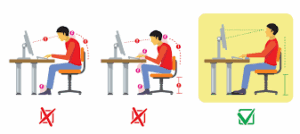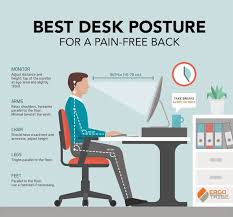

“Nerd neck,” “tech neck,” or “forward head posture”—call it what you will, but it is one of the unfortunate byproducts of our modern, screen-focused lifestyles.
Sitting hunched over a laptop or craning our heads toward smartphones for hours on end is practically the norm, but the long-term consequences can be severe.
Over time, this poor posture can lead to chronic neck pain, headaches, and even nerve damage.
The good news?
Fixing nerd neck might be as simple as adjusting your desk height!
In this article, we will explore how improper desk setups contribute to forward head posture and how making a few ergonomic tweaks can help you stand (or sit) tall again.
Ready to save your neck? Let’s dive in.
In This Article:
- What Is Nerd Neck and Why Does It Happen?
- The Role of Desk Height in Posture
- Signs That Your Desk Height Is Contributing to Nerd Neck
- Real-Life Example: How Kate Fixed Her Nerd Neck with Desk Adjustments
- Adjusting Desk Height: Standing vs. Sitting
- The Science Behind Desk Height and Forward Head Posture
- Other Ergonomic Adjustments to Consider
- Conclusion: Desk Height Is the First Step to Better Posture
What Is Nerd Neck and Why Does It Happen?
Before we get into the nitty-gritty of desk height adjustments, let’s talk about what nerd neck actually is.
Nerd neck, or forward head posture, is a condition where your head is positioned too far forward relative to your spine.
Over time, this places undue stress on your neck muscles, which are forced to work harder to keep your head balanced.
According to Dr. Kenneth Hansraj, a leading spinal and orthopedic surgeon, every inch your head leans forward adds an extra 10 pounds of pressure on your neck.
That means if your head is tilted forward by just three inches while you are working at your desk, your neck feels like it is carrying an additional 30 pounds!
This constant strain leads to tightness, discomfort, and can even cause long-term damage if not addressed.
So why does it happen?
The answer is simple: prolonged sitting in front of a desk, hunched over a screen that is positioned too low or too high.
Your body adapts to this position over time, reinforcing bad habits until nerd neck becomes your new normal.
The Role of Desk Height in Posture
Desk height is one of the most overlooked aspects of workplace ergonomics.
It is all too easy to get stuck working at a desk that is too low, too high, or just not suited to your body’s natural posture.
When your desk height is wrong, you compensate by craning your neck, slouching, or hunching your shoulders—all of which contribute to forward head posture.
An improper desk height forces you to either look down at your screen (if the desk is too low) or strain your neck upward (if it is too high).
Both positions can quickly lead to neck pain, shoulder tension, and the dreaded nerd neck.
But when your desk is adjusted properly, you can maintain a neutral spine, keeping your head, neck, and back aligned.
Signs That Your Desk Height Is Contributing to Nerd Neck
You may not even realize that your desk height is the culprit behind your poor posture, but here are a few telltale signs that it is time for an adjustment:
- Constant forward head position: If you find yourself regularly leaning forward to read your screen or hunching over your keyboard, that’s a clear sign.
- Frequent neck or upper back pain: Chronic pain in these areas often indicates that your neck is compensating for bad posture.
- Eye strain: Are you squinting or straining your eyes to see your screen? A poorly adjusted desk height can also impact your screen visibility, leading to more neck strain as you lean in to see better.
Real-Life Example:
Kate, a graphic designer, found herself experiencing chronic neck pain after spending hours working on her laptop each day.
She initially blamed her chair, thinking it was the root cause.
But after realizing her screen was too low and her desk was not adjusted properly, she made some quick fixes.
She elevated her desk and invested in a laptop stand to bring her screen to eye level—and within weeks, her neck pain subsided. Kate’s case is a great example of how desk height directly influences posture and comfort.
Adjusting Desk Height: Standing vs. Sitting
There is a lot of debate over whether sitting or standing desks are better for posture.
The truth is, both can work, but only if they are set up correctly.
For sitting desks: Your desk height should allow you to sit comfortably with your feet flat on the floor, your knees at a 90-degree angle, and your forearms parallel to the ground. Your screen should be at eye level to prevent you from craning your neck downward.
For standing desks: Adjust your desk so your elbows are at a 90-degree angle when typing, and your screen is once again at eye level. If the desk is too high, you’ll end up lifting your shoulders, which can lead to tension. If it’s too low, you’ll hunch forward—back to nerd neck territory.
The real key is to find a height that allows your body to remain in a neutral posture.
According to the Journal of Physical Therapy Science, neutral posture is when the head, spine, and pelvis are aligned naturally, without strain.
The Science Behind Desk Height and Forward Head Posture
The connection between desk height and forward head posture is not just anecdotal.
Scientific research backs up the idea that ergonomic adjustments can significantly reduce musculoskeletal discomfort.
A study in the Journal of Human Factors and Ergonomics found that proper desk height and screen positioning can reduce the incidence of forward head posture by as much as 30%.
What is happening in your body is a matter of biomechanics.
When you are seated or standing with an improperly adjusted desk, your body automatically compensates to maintain balance.
This compensation often results in what is known as “forward head posture,” where your neck and head shift forward, placing immense pressure on the cervical spine.
Other Ergonomic Adjustments to Consider
Adjusting your desk height is crucial, but it is not the only factor in fixing nerd neck.
Here are a few other ergonomic adjustments that can make a big difference:
- Chair height: Your chair should be adjusted so that your feet are flat on the ground, with your knees at a 90-degree angle. This helps keep your back and neck aligned.
- Monitor placement: Use a monitor stand or laptop riser to bring your screen to eye level. Your eyes should naturally land on the top third of the screen when looking straight ahead.
- Keyboard and mouse placement: Your keyboard and mouse should be positioned so your arms form a 90-degree angle, preventing shoulder strain. So, correct keyboard placement fixes fhp.
Real-Life Example: How Kate Fixed Her Nerd Neck with Desk Adjustments?
Let’s revisit Kate, our graphic designer.
Kate’s initial neck pain had her convinced she needed a new office chair.
But after researching ergonomic solutions, she realized her desk height was the problem.
Her laptop sat too low, forcing her to bend her neck forward for hours at a time.
After making two simple changes—elevating her laptop and adjusting her desk height—she noticed an immediate improvement.
She also began incorporating regular breaks to stretch her neck and shoulders.
Kate’s story highlights the importance of desk height in fixing posture.
Sometimes, it is the smallest adjustments that can have the biggest impact.
Desk Height Is the First Step to Better Posture
Best Forward Head Posture Fix does not require a drastic lifestyle change—it starts with something as simple as adjusting your desk height.
Whether you are using a sitting or standing desk, ensuring that your setup encourages a neutral posture is crucial for preventing and alleviating forward head posture.
Along with proper desk height, remember to adjust your chair, monitor, and keyboard to suit your body’s natural alignment.
By making these small but powerful adjustments, you can reduce the strain on your neck and back, improve your posture, and save yourself from the pain of nerd neck.
So go ahead—tweak your desk setup today, and give your neck the relief it has been craving!
References:

